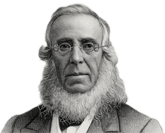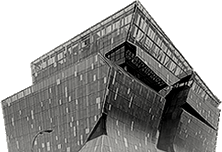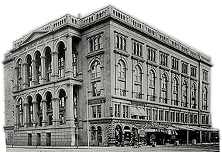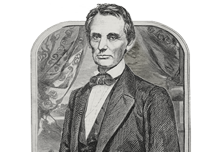Jack Whitten A'64
Perhaps best known for his deep explorations of materials, the painter Jack Whitten, who graduated from The Cooper Union’s School of Art in 1964, remained committed to his alma mater via The Saturday Program, a free program for New York City high school students to study art. Whitten, who was awarded the Presidential Medal of Arts by Barack Obama in 2015, hosted students at his studio each year and had a great impact on a generation of Saturday Program graduates.
While a student at Tuskegee University, Whitten experienced what he termed a revelation. Rising from his seat during an ROTC class, he was moved by a thunder strike of clarity, asking out loud, “What am I doing here?” He left Tuskegee, where he had been studying biology, but before leaving was offered one bit of advice from an architecture professor there: apply to a school in New York called The Cooper Union. He did just that and by the fall of 1960 had moved in with his traffic cop uncle in Queens and began classes with the likes of painter Robert Gwathmey, his drawing instructor, who helped him adjust to Cooper. He went to museums, studied the work of his classmates, and made a beeline to the famous hang out of the New York Abstract Expressionists, the Cedar Bar at 8th and University. There he met Willem de Kooning, who greatly influenced the early part of the young artist’s career. Robert Blackburn, who ran the school’s print shop and whom Whitten recalled as the only Black instructor at Cooper, introduced him to Romare Bearden, who in turn introduced him to Jacob Lawrence and Norman Lewis. Armed with their recommendations and his outsized talent, he was awarded a John Hay Whitney Fellowship, a $4,500 prize that he used to buy a wealth of supplies.
For many years, Whitten worked out of a studio on Lispenard Street in Tribeca. The artist, who had remodeled the building himself, made a perfectly level studio floor so that he could better control paint as he poured gallons of it onto canvas laid on the ground. From there, he might work the paint using an afro pick or later a machine of his own devising, a sort of large squeegee with teeth, that he would pull across the canvas.
At one point, he began cutting into multiple layers of paint and using them as tiles. They were essential to some of his best-known paintings including the Black Monolith series—tributes to important black American figures like Ralph Ellison and Amiri Baraka—and "9-11-01" (2005), a 10 x 20-foot canvas memorializing the September 11 attacks, which he witnessed from his downtown studio.
“He laid complex mosaics inside a frame on top of a table,” said Richard Jacobs, who graduated from the School of Art in 1984. “He explained how he completed the painting by sliding a sharp tool component across the work in a few seconds, cutting all the mosaic pieces down to one level and filling the grooves with medium….Jack painted ‘Whittens’ decades before Gerhard Richter painted ‘Richters’.”
Though he would explore a particular technique in extraordinary depth, his work was constantly evolving. The influence of biology, politics, fractal geometry, and surrealism can all be found in his oeuvre. It was the wide-ranging and fearless experimentation of Whitten’s work, in terms both of material and style, that so impressed his contemporaries and students.
He was a regular supporter of the Saturday Program, donating both money and time. Every year, he would host students at his studio, whether it was in Manhattan or in Jackson Heights where he kept his last studio. It was the highlight of the year. He would recount his youth, giving a searing first-hand account of living under segregation, and describe his art education, his thoughts on painting, and his belief that “you always get help along the way.” Jairo Sosa, a 2017 alumnus of the School of Art and the Saturday Program, remembers visiting the studio and seeing Mr. Whitten in his “uniform”, a lab coat and silver shoes, and being impressed with the eclectic collection of materials at hand—shells, model planes, fish bones, light bulbs, and most memorably blood, all of which might end up mixed into his paint or attached to his canvases.
In a 2009 interview that he gave to the Smithsonian’s American Archives of Art he said, “I come from a point of view which says that no one teaches art and surely Jack Whitten doesn’t teach art…I teach the means to acquire art.”
He did just that for Tomashi Jackson, a gifted artist and 2010 graduate of the School of Art. Though she never studied with Mr. Whitten at Cooper, she did meet him informally at Yale. He agreed to come to her studio to look at her art. “We looked a lot and closely and talked a lot. One very significant thing that happened was that Jack saw what was happening around one of the works as a part of the language of the painting itself. I was rigidly considering that thing he saw as a practical necessity for the making of the thing. We kept looking and talking. The work matured that day.”
Though his art had been shown steadily throughout his career—at the Whitney, the Met, and the Studio Museum in Harlem— over the past decade, his work has received greater recognition, including a retrospective at the Museum of Contemporary Art San Diego entitled “Jack Whitten: Five Decades of Painting.” In April 2018, “Odyssey: Jack Whitten Sculpture 1965-2017” was shown at the Baltimore Museum of Art and the Metropolitan Museum of Art. This March, New York’s Museum of Modern Art will present Jack Whitten: The Messenger. The exhibition, which features work never before shown publicly, is open until August 2, 2025.






